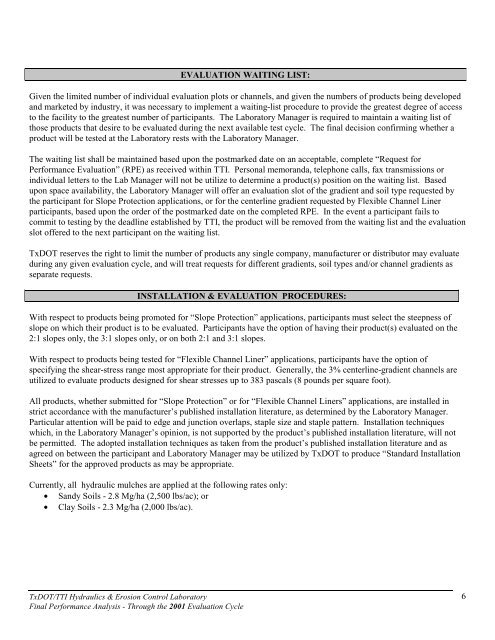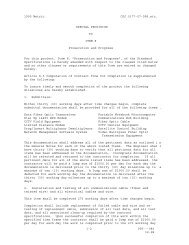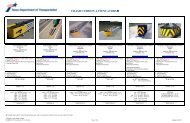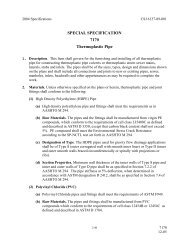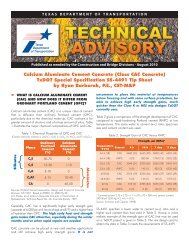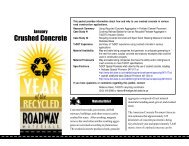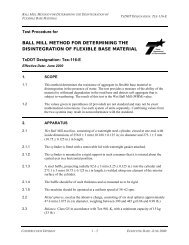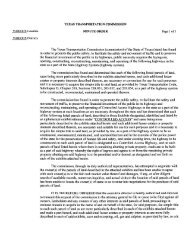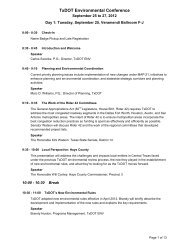TxDOT/TTI HYDRAULICS & EROSION CONTROL LABORATORY
TxDOT/TTI HYDRAULICS & EROSION CONTROL LABORATORY
TxDOT/TTI HYDRAULICS & EROSION CONTROL LABORATORY
Create successful ePaper yourself
Turn your PDF publications into a flip-book with our unique Google optimized e-Paper software.
<strong>TxDOT</strong>/<strong>TTI</strong> Hydraulics & Erosion Control Laboratory<br />
Final Performance Analysis - Through the 2001 Evaluation Cycle<br />
EVALUATION WAITING LIST:<br />
Given the limited number of individual evaluation plots or channels, and given the numbers of products being developed<br />
and marketed by industry, it was necessary to implement a waiting-list procedure to provide the greatest degree of access<br />
to the facility to the greatest number of participants. The Laboratory Manager is required to maintain a waiting list of<br />
those products that desire to be evaluated during the next available test cycle. The final decision confirming whether a<br />
product will be tested at the Laboratory rests with the Laboratory Manager.<br />
The waiting list shall be maintained based upon the postmarked date on an acceptable, complete “Request for<br />
Performance Evaluation” (RPE) as received within <strong>TTI</strong>. Personal memoranda, telephone calls, fax transmissions or<br />
individual letters to the Lab Manager will not be utilize to determine a product(s) position on the waiting list. Based<br />
upon space availability, the Laboratory Manager will offer an evaluation slot of the gradient and soil type requested by<br />
the participant for Slope Protection applications, or for the centerline gradient requested by Flexible Channel Liner<br />
participants, based upon the order of the postmarked date on the completed RPE. In the event a participant fails to<br />
commit to testing by the deadline established by <strong>TTI</strong>, the product will be removed from the waiting list and the evaluation<br />
slot offered to the next participant on the waiting list.<br />
<strong>TxDOT</strong> reserves the right to limit the number of products any single company, manufacturer or distributor may evaluate<br />
during any given evaluation cycle, and will treat requests for different gradients, soil types and/or channel gradients as<br />
separate requests.<br />
INSTALLATION & EVALUATION PROCEDURES:<br />
With respect to products being promoted for “Slope Protection” applications, participants must select the steepness of<br />
slope on which their product is to be evaluated. Participants have the option of having their product(s) evaluated on the<br />
2:1 slopes only, the 3:1 slopes only, or on both 2:1 and 3:1 slopes.<br />
With respect to products being tested for “Flexible Channel Liner” applications, participants have the option of<br />
specifying the shear-stress range most appropriate for their product. Generally, the 3% centerline-gradient channels are<br />
utilized to evaluate products designed for shear stresses up to 383 pascals (8 pounds per square foot).<br />
All products, whether submitted for “Slope Protection” or for “Flexible Channel Liners” applications, are installed in<br />
strict accordance with the manufacturer’s published installation literature, as determined by the Laboratory Manager.<br />
Particular attention will be paid to edge and junction overlaps, staple size and staple pattern. Installation techniques<br />
which, in the Laboratory Manager’s opinion, is not supported by the product’s published installation literature, will not<br />
be permitted. The adopted installation techniques as taken from the product’s published installation literature and as<br />
agreed on between the participant and Laboratory Manager may be utilized by <strong>TxDOT</strong> to produce “Standard Installation<br />
Sheets” for the approved products as may be appropriate.<br />
Currently, all hydraulic mulches are applied at the following rates only:<br />
• Sandy Soils - 2.8 Mg/ha (2,500 lbs/ac); or<br />
• Clay Soils - 2.3 Mg/ha (2,000 lbs/ac).<br />
6


